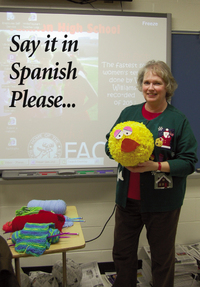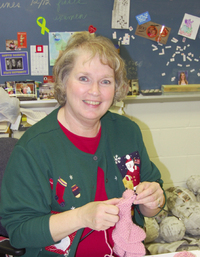
It is not uncommon for teachers to only spend 3-5 years at a particular job, which makes Judy Tereshinski’s longevity at Yankton High School that much more impressive.
“I started at Yankton High School right out of Yankton College,” Judy said. “So far, I’ve been here at YHS for 42 years.”
Judy currently teaches Spanish I-III and Advanced Placement (AP) Spanish, but as a math and Spanish major she’s also taught Algebra I at different times during her career.
As a graduate of Yankton High School, Judy said her first years of teaching were surreal.
“It was a little tricky for me because when I was a new teacher many of my colleagues were teachers who had taught me just a few years before that,” she said. “I was always a little cautious because I thought I was going to say the wrong thing to them, I was afraid I’d make mistakes, but I always had someone I could go to when I needed help.”
Judy has now come full circle, she said.
“Many times a student of mine has become a teacher here and now the roles are reversed,” she said. “As the oldest teacher in the building I try to help out as much as I can, but young teachers today are very adapt at finding their own way.”
During her career, Judy said the ways of accomplishing her job have changed — for the better mostly — but the actual job is pretty much the same.
“When I first started teaching we took attendance by hand and put a little scrap of paper out on the door every hour and someone came around and collected it and tallied the absences. Now we just do it on the computer and you can immediately see all the absences and tardies. We also do all our lesson plans on computers and the students and the teachers can go look at them any time.”
There are also differences in the lunches and the way lessons are taught, Tereshinski said.
“We are all more aware of our caloric intake,” she said. “The SMART board is pretty amazing. We can pull up anything right before their eyes. Some days the students wonder if they need the teacher, but the teacher/student rapport is still important.”
Although the technological changes have made many parts of teaching easier, Tereshinski is still “old school” in many ways.
“I still keep a hard copy grade book and write my lesson plans out on the chalkboard,” she said. “You can put it on the computer but some kids still need to say it, write it and repeat it to remember it.
“The kids still have the same problems, they are still inquisitive, which is great,” she said. “The kids still don’t like homework, but I think it’s important to have homework every day so you have a chance to review what was done in class and practice doing it right away.”
The kids in Tereshinski’s classroom not only have similar problems and complaints of the students of generations past; they also sit in the same desks.
“I have all the same desks from when I started in 1970. I told the administration there was no need to get new ones,” she said.
“The new ones aren’t made as well. These are made to last and we might as well save the money and keep using them as long as they are still in good shape.”
One of the secrets to Tereshinski’s longevity is fun.
“I like to have fun in the classroom,” she said. “I am very structured but I like to have fun and be spontaneous sometimes. The other day I introduced my class to ‘Schoolhouse Rock,’ because we were working on adverbs. We watched ‘Lolly, Lolly, Lolly, Get Your Adverbs Here!’ I’m a stickler for grammar and a lot of my kids learn their English grammar from Spanish class. It’s fun to do something different every once in a while, it only took three minutes but it had a message and it’s something that will stick with them.”
Every class Tereshinski makes her way around the room and checks every one of her students’ homework.
“For some students that is the only communication they have with an adult all day,” she said. “I always talk to my students in Spanish and they always have to speak to me in Spanish. Even when I see them out in public I speak to them only in Spanish. It drives my husband nuts.”
Tereshinski likes to continue her lessons outside of the classroom.
“We go out to eat at one of the local Mexican restaurants,” she said. “And we do several cultural activities throughout the year. We go to the elementary schools each spring and teach the elementary students some Spanish. I have taken groups of students on trips to Spain, France and Italy. That is a very rewarding experience there is nothing like visiting another culture and being totally immersed in it. That’s how you really learn.”
She also has her students make piñatas each year.
“For a bit when we’re making them my classroom looks more like an elementary classroom,” Judy said. “But it’s good to have a break from books and lessons and work with glue and papiermâché. They can make anything they want as long as it’s appropriate. We do our regular classwork and then spend a few minutes at the end of class working on them. They get them done right before the Christmas holidays and then they can bring them home and fill them with candy and incorporate them into their Christmas holiday.”
Tereshinski has also incorporated other elementary-school traditions into her high school classroom.
“I love food so when it is your birthday you can bring treats to share in my class,” she said. “I had a few students who were perplexed about the disappearance of cursive writing so we decided to revive it. We do sentences on the board and then we rate who has the best cursive handwriting.”
Because Spanish is an elective, Tereshinski is blessed to have students in her classes that really want to be there.
“There is no mandate that they have to take Spanish,” she said.
“It is one of the requirements for the state scholarship and many out-of-state colleges require two years of a foreign language and of course there are parents who think they need it but for the most part they want to learn. I have heard many times over the years that the students at Yankton High School are the most prepared students in a lot of areas not just Spanish and I think that speaks well of YHS.”
Tereshinski also enjoys knitting and has started an informal Knitting Club at the high school.
“I wore a scarf to school one day and someone asked me where I got it and I said I had knitted it,” she said. “A few students were interested in learning to knit so for the past four years I’ve had kids come in for knitting club. I let the kids knit sometimes when they are done with their lessons and then once a week I have a session after school.”
Surprisingly the knitting club is pretty popular among the boys at YHS.
“Last fall, I had four football players and a wrestler,” she said.
“The girls start out coming and then once they get the hang of it they stop coming to the club and just continue on their own but the boys come for quite a while. The wrestler said he wanted to learn to knit to keep him busy. It was something he could do to keep his fingers busy when he was trying to avoid eating to make weight.”
Tereshinski said when she was growing up her mother encouraged her and her two sisters to choose a career to make sure they could provide themselves with an income in case something should happen to their husbands.
“One of my sisters became a nurse and the other a secretary,” she said. “Back then there weren’t many careers to choose from for women. I could have been a beautician but I chose teacher. I think it was a good choice. I do like snow days.”
She said each year she is asked when she’s going to retire.
“I always say not yet, I think I’ll do one more year,” Tereshinski said. “I’ll just take it one year at a time. I love being with my students and I’m just not ready to sit at home just yet.”



